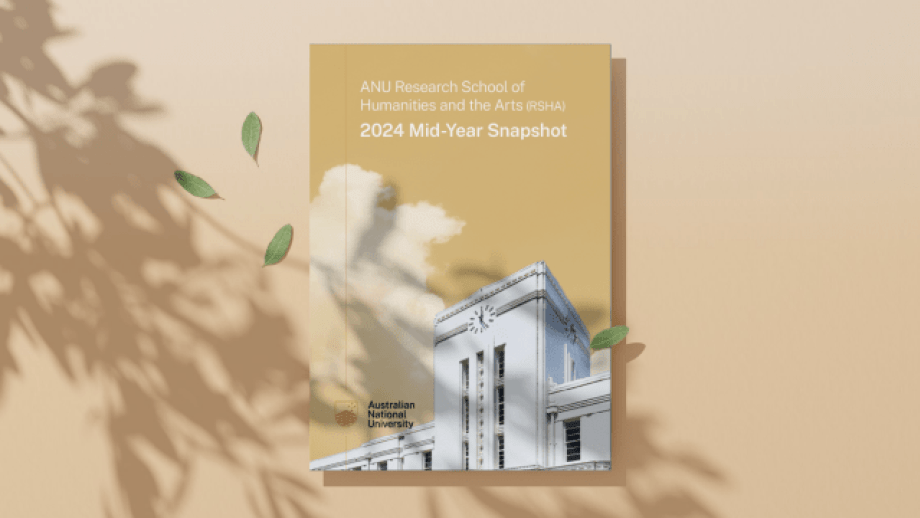ANU School of Art & Design celebrates achievements in mid-year snapshot

Read full RSHA 2024 Mid-Year Report here.
Highlights for the ANU School of Art & Design
New Australian Research Council Projects
ARC Linkage Project (LP)
Dialogue with Difficult Objects: Mediating Controversy in Museums, $404, 596
This project aims to support proactive engagement with controversial objects in Australian museums. With the Eureka Flag as a case study, new tools for community dialogue
and engagement will be developed using innovative methods for voicing and mediating difference. Expected outcomes include new strategies for developing museum exhibitions, publications, and educational resources, as platforms for diversity and tolerance. The project aims to provide significant civic benefits by developing a transferable framework equipping museums to counter social fragmentation with respectful debate and inclusive engagement. More.
Dialogue with Difficult Objects: Mediating Controversy in Museums, $404, 596
This project aims to support proactive engagement with controversial objects in Australian museums. With the Eureka Flag as a case study, new tools for community dialogue
and engagement will be developed using innovative methods for voicing and mediating difference. Expected outcomes include new strategies for developing museum exhibitions, publications, and educational resources, as platforms for diversity and tolerance. The project aims to provide significant civic benefits by developing a transferable framework equipping museums to counter social fragmentation with respectful debate and inclusive engagement. More.
"Our project aims to equip museums to counter social fragmentation with respectful debate and inclusive engagement.”
Emeritus Professor Chris McAuliffe & Dr Raquel Ormella
From discard to discourse: transforming waste into critical design examining extraction and sustainability
Discarded wood furniture, a significant source of waste, has been reimagined by RSHA Senior Lecturer Ms Ashley Eriksmoen in her project Fell.
The National Gallery of Victoria (NGV) in Melbourne commissioned the work for its 2023 NGV Triennial—a peak international exhibition presenting globally significant projects intersecting contemporary art, design and architecture attended by 1,063,675 visitors. Fell consists of a life-sized tree stump and log, constructed from salvaged furniture components collected off Canberra’s streets. Through studio practice, Eriksmoen critically examines the relationship between humans and the environment, addressing links between resource extraction, deforestation, consumerism and waste. By transforming furniture back into tree forms, Eriksmoen encourages viewers to reconsider material consumption habits. Fell enriches the dialogue on the impact of colonial legacies on contemporary resource usage. Now in the NGV’s permanent collection, it is the focus of an educational workshop co-created by Eriksmoen and the NGV for visiting school groups, further extending its impact beyond the exhibition space. More.
Turning metabolism into art: moving from body image to body process in contemporary practice
Food is widely depicted in the arts through different forms of creative expression. However, despite food’s centrality in sociocultural life, artistic interest has traditionally revolved around the act of eating. What if, instead, we shifted the focus from ingestion to digestion?
In After Eating, RSHA Associate Professor Lindsay Kelley explores the emerging field of metabolic arts, claiming digestion and metabolism are key cultural, creative, and political processes that demand attention. Taking an artist-centered approach to nutrition, Kelley’s book cultivates a neglected middle ground between the everyday and the scientific, using metabolism as a lens through which to read and write about art. By engaging the notion of “after” as an artistic homage or tribute, metabolism moves beyond the cell to transform into a method for responding to the most difficult cultural, environmental, philosophical, and political challenges of the contemporary moment. Through “metabolic readings”, Kelley is rethinking feminist, queer, bioart, installation, and performance projects, providing artists, students, and teachers with new pathways into art theory. More.
Unlocking a national treasure: the Emmerson Collection at State Library Victoria
In 2015, John Emmerson gave a collection of over 5,000 rare books and manuscripts to State Library Victoria, placing into Australian public ownership a national treasure: the first and only early modern archive of scale to be held by an Australian institution.
Assembled over a lifetime by Australia’s foremost private collector of early modern books, the archive’s contents were virtually unknown, its significance unexplored and its value untapped, even by the librarians to whom its care was entrusted.
RSHA researchers Professor Rosalind Smith and Professor Mitchell Whitelaw, together with an international team of early modern specialists, rare book librarians and project PhD student Julia Rodwell, partnered with State Library Victoria to transform this physical archive from obscurity to a widely-used, internationally-recognised collection of significance. More.
Naabámi: an intergenerational celebration of First Nations women in honour of Barangaroo
Artist and RSHA Professor Brenda L Croft is shining a spotlight on contemporary First Nations women through her creative-led research project Naabámi (thou shall/will see): Barangaroo (army of me).
This non-traditional research output showcases over 100 photographs of First Nations women and girls with diverse cultural affiliations from regions across the continent of Australia, with a particular focus on the Dharawal community at La Perouse, Sydney. The images were created using the 19th century wet plate collodion process, referencing colonial ethnographic photography. The series is inspired by Barangaroo (c1750–91), the Cammeraygal woman documented in the earliest colonial records and renowned for her mastery as a fisherwoman and her staunch, non-negotiable attitude towards the early colonisers. In Nabaami, the viewer is invited to reflect on the potency and fortitude of Australian First Nations
women and girls. Professor Croft’s burgeoning ‘army’ of female Australian First Nations warriors comprises great-grandmothers, grandmothers, mothers, aunts, sisters, daughters, granddaughters and great-grand-daughters, drawn from her longstanding community connections spanning almost four decades. More.
women and girls. Professor Croft’s burgeoning ‘army’ of female Australian First Nations warriors comprises great-grandmothers, grandmothers, mothers, aunts, sisters, daughters, granddaughters and great-grand-daughters, drawn from her longstanding community connections spanning almost four decades. More.